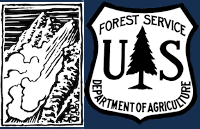24-25
Small soft slab avalanche south of Bradley's Meadow
Above Bradley's Meadow, we triggered a small soft slab avalanche on a south facing aspect around 7800'. This avalanche broke in a wind drift, 4" deep in low density new snow, likely on a sun crust or near-surface facets.
We triggered a small soft slab avalanche on a south facing aspect around 7800'. This avalanche broke in a wind drift, 4" deep in low density new snow, likely on a sun crust or near-surface facets. Photo: GNFAC
We triggered a small soft slab avalanche on a south facing aspect around 7800'. This avalanche broke in a wind drift, 4" deep in low density new snow, likely on a sun crust or near-surface facets. Photo: GNFAC
Forecast link: GNFAC Avalanche Forecast for Mon Jan 20, 2025
Wind Drifts and Deep Snow in the Bridgers
Today, we braved the frigid temperatures and toured out of the Bradley's Meadow gate north of Bridger Bowl. Above Bradley's Meadow, we triggered a small soft slab avalanche on a south facing aspect around 7800'. This avalanche broke in a wind drift, 4" deep in low density new snow, likely on a sun crust or near-surface facets.
We toured up the Ramp and dug a snowpit on north facing aspect at 8200' Here we found a strong, deep snowpack just over 5' deep. Under 4" of new snow, we found a decomposing melt-freeze crust with near-surface facets, and underneath, a mostly right-side-up snowpack structure. The facets near the bottom of the snowpack have gained strength and were hard and rounding. We did not get unstable results in our pit tests here.
Additionally, during steady snowfall from late December through early January, in the Bridger Range and mountains near Bozeman we saw minimal (if any) avalanches break on weak snow near the bottom of the snowpack. This minimal activity combined with what we have been seeing in snowpits indicates deeper avalanches are unlikely.
Cracking within shallow wind slabs was the only sign on instability we saw today. We chose to ski 30-35º terrain, assessing for and steering clear of wind drifted snow as we made our way down.
Light snow fell all day (S1) and winds were calm on the ridge. There was also evidence of the strong winds earlier in the week in the form of large drifts in unusual locations across lower elevations. These drifts are worth being cautious of, though they are now stubborn to unreactive and being disguised by the new snow.
Variable Snow in Hellroaring
Toured up W. Facing terrain on Mt. Nemesis coming out of the hut. Full range of sun crust, rime crust, wind crust, and consolidated powder between SW to NW aspects. Snow structure felt consolidated and stable in most areas but became hollow and slabby in rocky terrain ~8,800’ . We turned back and found a lower angle path down to the skin track.
Mt. Ellis update
Additonal information for my mt ellis post, 1/17/2025. My description of the pit snow profile left out the bottom 15-20 cms which was the ever present sw montana faceted snow. It did show signs of healing.
GNFAC Avalanche Forecast for Sun Jan 19, 2025
<p><span><span><span><span><span><span>A person can trigger avalanches 2-4 feet deep, or deeper on some wind-loaded slopes, which break on persistent weak layers near the bottom of the snowpack. You are more likely to trigger these big </span></span></span></span></span></span><span><span><span><strong><span><span>persistent slab avalanches </span></span></strong></span></span></span><span><span><span><span><span><span>on slopes with snow depths less than 3-4 ft deep. On big slopes where snow depth varies you can trigger one of these slides from a thinner area and it can break wide into a deeper part of the slope. Choose slopes that are non-wind-loaded and with a relatively deep and more uniform snow depth, or stay on slopes less than 30 degrees to keep it simple. Recent avalanches show some of the types of terrain to avoid to minimize triggering a persistent slab avalanche (</span></span></span></span></span></span><a href="https://www.mtavalanche.com/node/33584"><span><span><span><strong><span… Mountain</span></span></u></span></strong></span></span></span></a><span><span><span><span><span><span>, </span></span></span></span></span></span><a href="https://www.mtavalanche.com/node/33544"><span><span><span><strong><span… Ridge 1</span></span></u></span></strong></span></span></span></a><span><span><span><span><span><span>, </span></span></span></span></span></span><a href="https://www.mtavalanche.com/node/33528"><span><span><span><strong><span… Ridge 2</span></span></u></span></strong></span></span></span></a><span><span><span><span><span><span>).</span></span></span></span></span></span></p>
<p><span><span><span><span><span><span>Additionally, </span></span></span></span></span></span><span><span><span><strong><span><span>wind slab avalanches </span></span></strong></span></span></span><span><span><span><span><span><span>can be triggered where the recent snow has been drifted into soft slabs up to 1-2 feet thick. Assess the snowpack for unstable drifts, assess the terrain for consequences like cliffs, trees and gullies, and remember even a small slide can easily knock you down. Human-triggered avalanches are possible and the avalanche danger is MODERATE near Cooke City, West Yellowstone and in the southern Madison and Gallatin Ranges.</span></span></span></span></span></span></p>
<p><span><span><span><span><span><span>Near Bozeman, Big Sky and Island Park </span></span></span></span></span></span><span><span><span><strong><span><span>wind slab avalanches</span></span></strong></span></span></span><span><span><span><span><span><span> can be triggered where recent snow has been drifted into slabs up to a couple feet thick. Watch for drifting snow off ridgelines (</span></span></span></span></span></span><a href="https://www.mtavalanche.com/images/25/saddle-peak-wind-transport"><span…;) and cracking across the snow surface (</span></span></span></span></span></span><a href="https://www.mtavalanche.com/images/25/shooting-crack-jefferson-17-jan-2…;) as signs that fresh wind slabs exist. Older drifts of snow that formed over the last week will be more stubborn, but worth watching out for. Note that strong winds last week formed some drifts in less typical locations like lower elevations.</span></span></span></span></span></span></p>
<p><span><span><span><span><span><span>Avalanches breaking on persistent weak layers are unlikely in these parts of our forecast area. However, buried weak layers do exist, so it is worth choosing slopes with a deeper, more uniform snow depth. See our recent observations from </span></span></span></span></span></span><a href="https://www.mtavalanche.com/node/33746"><span><span><span><span><span><… Park</span></span></u></span></span></span></span></span></a><span><span><span><span><span><span> and </span></span></span></span></span></span><a href="https://www.mtavalanche.com/node/33742"><span><span><span><span><span><…. Ellis</span></span></u></span></span></span></span></span></a><span><span><span><span><span><span>, and </span></span></span></span></span></span><a href="https://www.youtube.com/watch?v=63ynwwMOJ4U"><span><span><span><span><s…’s video</span></span></u></span></span></span></span></span></a><span><span><span><span><span><span> for more info on this unlikely persistent slab problem.</span></span></span></span></span></span></p>
<p><span><span><span><span><span><span>In the mountains around Bozeman, Big Sky, and Island Park the avalanche danger is MODERATE on wind-loaded slopes and LOW on other slopes. Assess the snowpack for buried weak layers and unstable drifts before committing to steep slopes.</span></span></span></span></span></span></p>
KING AND QUEEN OF THE RIDGE
Do you like to hike? Do you like to ski/ride? Then the King & Queen of the Ridge on 2/1 is for you. Hike, ride and raise money for the Friends of the Avalanche Center at Bridger Bowl this year! Join this fun event to promote and support avalanche safety and awareness! Fundraising prizes for the top 5 individuals who raise over $500.
